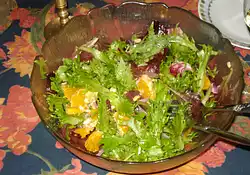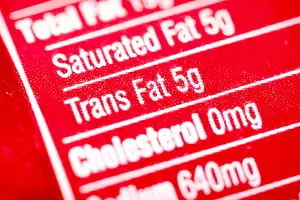Pine nuts
About the ingredient pine nuts. Including 360 recipes with pine nuts, nutrition data, and where to find it.
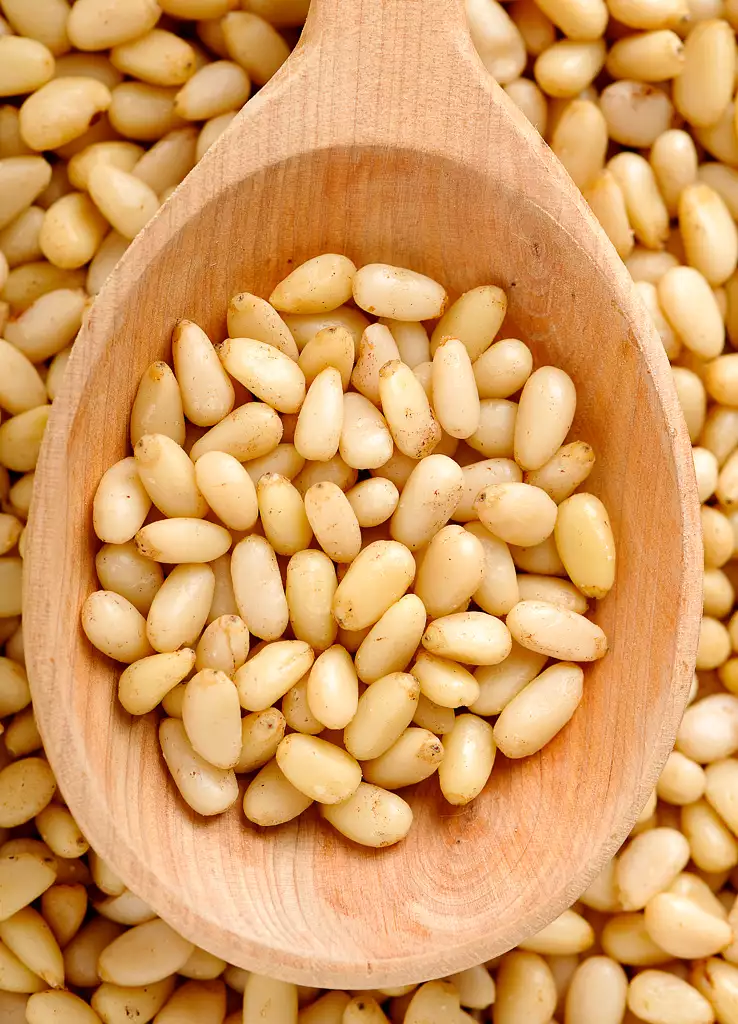
Contents
What are pine nuts?
Pine nuts contain, depending on species, between 10–34% protein, with Stone Pine having the highest content.
When first extracted from the pine cone, they are covered with a hard shell (seed coat), thin in some species, thick in others. The nutrition is storembryo (sporophyte) in the centre. Although a nut in the culinary sense, in the botanical sense pine nuts are seeds; being a gymnosperm, they lack a carpel (fruit) outside.
The shell must be removed before the pine nut can be eaten. Unshelled pine nuts have a long shelf life if kept dry and refrigerated (at –5 to +2 °C); shelled nuts (and unshelled nuts in warm conditions) deteriorate rapidly, becoming rancid within a few weeks or even days in warm humid conditions.
Pine nuts are commercially available in shelled form, but due to poor storage, can have poor flavour and may be already rancid at the time of purchase. Consequently, pine nuts are often frozen to preserve their flavour.
Nutrition
Nutrition Facts
Serving Size 1 cup (135g)Where found
Pine nuts are usually found in the baking supplies section or aisle of the grocery store or supermarket.
Food group
Pine nuts are a member of the Nut and Seed Products US Department of Agriculture nutritional food group.
How much do pine nuts weigh?
| Amount | Weight |
|---|---|
| 1 cup | 135 grams |
| 1 oz (167 kernels) | 28 grams |
| 10 nuts | 1 grams |
Related
Nut and Seed Products
| In Chinese: | 松子 | |
| British (UK) term: | ||
| en français: | pignons de pin | |
| en español: | piñones |
Recipes using pine nuts
There are 360 recipes that contain this ingredient.
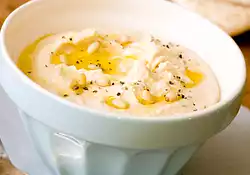
Hummus Bi Tahini
Hummus Bi Tahini recipe
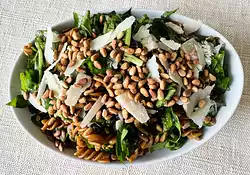
Spinach, Sun-dried Tomato, Parmesan & Pine Nut Pasta Salad
Fresh spring spinach simply dressed with olive oil and umami-packed ingredients like sun-dried tomatoes, Parmesan and pine nuts with pasta to make it a simple yet sophisticated picnic friendly salad.
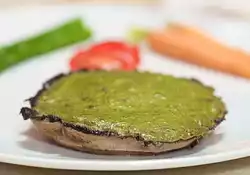
Cheesy Pesto Stuffed Mushrooms
A cheesy and scrumptious side dish that goes perfect with mashed potatoes or any pasta dish.
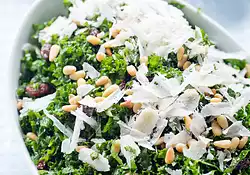
Kale Salad with Pinenuts, Currants & Parmesan
In a surprising twist, Tuscan kale is served raw—and makes for a substantial and satisfying fall salad. Sweet currants (or raisins) soaked in tangy white balasmic vingegar and salty parmesan punctuate the dressed, shredded kale.
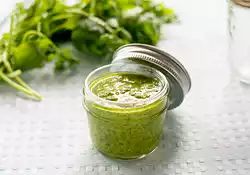
Cilantro Pesto
This cilantro pesto was so yummy, now I know what to do when I need to use up the fresh cilantro and parsley. I spread it on toast, pizza, even on crackers. So good!
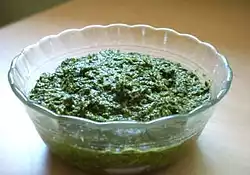
Fresh Basil Pesto
I use this in my Pesto Chicken Florentine

Broiled Tofu With Cilantro Pesto
This Tofu Gets It's Brillant Color and Delightful Flavor From An Easy Cilantro Pesto And Lime Juice!! Great Side Dish!!

Broiled Tofu With Cilantro Pesto
This Tofu Gets It's Brillant Color and Delightful Flavor From An Easy Cilantro Pesto And Lime Juice!! Great Side Dish!!

Heirloom Tomato Taco
This is called the Giuseppe Taco, we got the recipe from El Gastronomo Vagabundo taco truck.

Brussels Sprouts & Salami Pasta with Pine Nuts
This simply delicious dish takes no time to make, and it's an excellent way to add some nutrition-packed veggies and nuts into your diet.
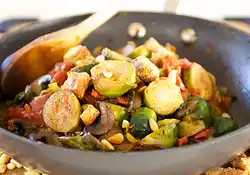
Tomato Braised Brussel Sprouts with Pine Nuts & Croutons
Brussel sprouts are sauteed with browned mushrooms, braised in a tasty tomato sauce, and served with toasted pine nuts and homemade croutons.
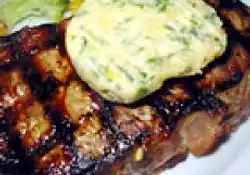
Beef Tenderloin with Gorgonzola Nut & Herb Butter
Beef Tenderloin with spicy Gorgonzola cheese and Pine Nut Herb Butter
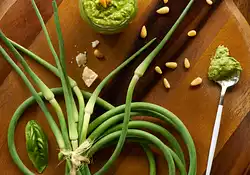
Garlic Scape Pesto
Turn farmer's market garlic scapes into a fresh & brightly flavored green pesto. An early summer seasonal treat.

Roasted Winter Squash Soup
On a cold day, let this delicious roasted winter squash soup warm up your whole body.
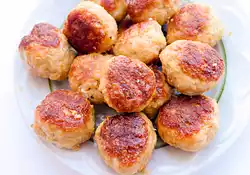
Lamb Meatballs, Persian Style
Lamb Meatballs, Persian Style recipe
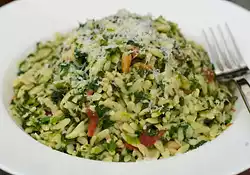
Orzo with Spinach & Pine Nuts (Milliken & Feniger)
Orzo, spinach and pine nuts, with garlic, tomatoes and a bit of romano cheese makes an elegant side dish.
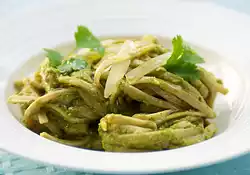
Pasta with Creamy Avocado Pesto
This avocado pesto is so creamy, tasty and refreshing. Toss the pasta with it to make a quick, wholesome and delicious week-day meal.
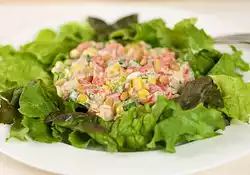
Greens with Roasted Corn & Pepper Salad
This is one of my favorites, and is always a hit when I bring it to potlucks.

Couscous with Fennel & Pinenuts
Quick, easy and delicious. Serve it as a side dish or a vegetarian main dish by using vegetable broth.

Lemon Pasta with Asparagus & Pine Nuts
You will not only love the bright colour of this dish, but also love the fragrant flavour. Use whole wheat pasta to add extra fibre. Enjoy!

Baba Ganoush with Pine Nuts
This was FANTASTIC!! I am not a huge fan of eggplant, but I recently tried baba ganoush at a restaurant. I really, really liked it so I had to find a recipe to try at home. This was a huge success. Very easy recipe to make and very, very tasty!!
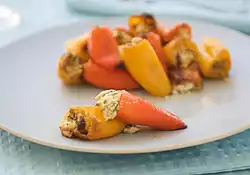
Goat Cheese & Herbs Stuffed Baby Peppers
Fresh herbs and creamy goat cheese are stuffed into these fresh baby peppers, roasting develops lots of flavor, and the balsamic glaze adds the extra zing. It can be a tasty appetizer, or can be served with main course.
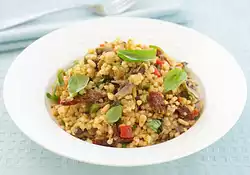
Israeli Couscous with Sauteed Mushrooms, Pine Nuts & Sun-Dried Tomatoes
Earthy sauteed mushrooms, aromatic toasted pine nuts, chewy-sweet sun-dried tomatoes make this delicious and wholesome couscous salad. Enjoy it as a side dish or serve it as a tasty main meal.
